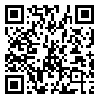Volume 14, Issue 2 (6-2024)
J Health Saf Work 2024, 14(2): 385-425 |
Back to browse issues page
Download citation:
BibTeX | RIS | EndNote | Medlars | ProCite | Reference Manager | RefWorks
Send citation to:



BibTeX | RIS | EndNote | Medlars | ProCite | Reference Manager | RefWorks
Send citation to:
Khosravi Y, Shakourian F Z, Eshaghi N, Seydi E, Hassanzadeh-Rangi N. Orientation and Scientific Trend of Occupational Safety Studies published in Persian Scientific Journals of Iran from 2011 to 2022. J Health Saf Work 2024; 14 (2) :385-425
URL: http://jhsw.tums.ac.ir/article-1-6989-en.html
URL: http://jhsw.tums.ac.ir/article-1-6989-en.html
Yahya Khosravi1 
 , Fatemeh Zahra Shakourian2
, Fatemeh Zahra Shakourian2 
 , Narges Eshaghi2
, Narges Eshaghi2 
 , Enayatollah Seydi3
, Enayatollah Seydi3 
 , Narmin Hassanzadeh-Rangi *
, Narmin Hassanzadeh-Rangi * 
 3
3

 , Fatemeh Zahra Shakourian2
, Fatemeh Zahra Shakourian2 
 , Narges Eshaghi2
, Narges Eshaghi2 
 , Enayatollah Seydi3
, Enayatollah Seydi3 
 , Narmin Hassanzadeh-Rangi *
, Narmin Hassanzadeh-Rangi * 
 3
3
1- Department of Occupational Health and Safety Engineering, School of Health, Alborz University of Medical Sciences, Karaj, Iran | Research Center for Health, Safety and Environment, Alborz University of Medical Sciences, Karaj, Iran | Non-Communicable Research Center, Alborz University of Medical Sciences, Karaj, Iran
2- Member of Student Research and Technology Committee, Alborz University of Medical Sciences, Karaj, Iran
3- Department of Occupational Health and Safety Engineering, School of Health, Alborz University of Medical Sciences, Karaj, Iran | Research Center for Health, Safety and Environment, Alborz University of Medical Sciences, Karaj, Iran
2- Member of Student Research and Technology Committee, Alborz University of Medical Sciences, Karaj, Iran
3- Department of Occupational Health and Safety Engineering, School of Health, Alborz University of Medical Sciences, Karaj, Iran | Research Center for Health, Safety and Environment, Alborz University of Medical Sciences, Karaj, Iran
Abstract: (769 Views)
Introduction: One of the questions that always arises in the minds of researchers, especially young researchers, is what pattern the progress of science follows in their field of expertise and what is the direction of the studies. The purpose of this study is to analyze the content of the studies published from 2011 to 2022 in Persian scientific journals in the field of workplace safety and determine the direction and scientific process of studies in this field.
Material and Methods: All the studies published from the years 2011 to 2022 in the Persian scientific research journals ”Iran Occupational Health”, “Occupational Health and Safety”, “Occupational Health Engineering”, ”Iranian Journal of Ergonomics”, “Occupational Medicine” and “Occupational Health and Health Promotion” were gathered using census method from the websites of the journals. In total, 595 published articles were categorized according to the thematic codes determined by the opinion of experts, the theme of “risk analysis, assessment, and risk management” had the highest percentage of frequency (18.66 percent), while the theme of “safety application in other industries or specific workplaces” had the lowest frequency of percentage (0.34 percent). Approximately 50 percent of the variance of the published studies explained the themes of “risk analysis, risk assessment, and management”, “inspection, analysis and modeling of accidents”, “human error and safety”, “social, organizational factors, culture, safety climate, and behavior-based safety”.
Conclusion: The existing trends emphasize the importance of learning lessons from accidents as a reactive approach and risk management, human factors, and behavioral aspects in safety interventions as a preventive approach. The research development of the country’s safety at the workplace should be further improved with new policies in different fields while taking advantage of international scientific advances on the specific functions and challenges of the country and with a problem-oriented approach.
Material and Methods: All the studies published from the years 2011 to 2022 in the Persian scientific research journals ”Iran Occupational Health”, “Occupational Health and Safety”, “Occupational Health Engineering”, ”Iranian Journal of Ergonomics”, “Occupational Medicine” and “Occupational Health and Health Promotion” were gathered using census method from the websites of the journals. In total, 595 published articles were categorized according to the thematic codes determined by the opinion of experts, the theme of “risk analysis, assessment, and risk management” had the highest percentage of frequency (18.66 percent), while the theme of “safety application in other industries or specific workplaces” had the lowest frequency of percentage (0.34 percent). Approximately 50 percent of the variance of the published studies explained the themes of “risk analysis, risk assessment, and management”, “inspection, analysis and modeling of accidents”, “human error and safety”, “social, organizational factors, culture, safety climate, and behavior-based safety”.
Conclusion: The existing trends emphasize the importance of learning lessons from accidents as a reactive approach and risk management, human factors, and behavioral aspects in safety interventions as a preventive approach. The research development of the country’s safety at the workplace should be further improved with new policies in different fields while taking advantage of international scientific advances on the specific functions and challenges of the country and with a problem-oriented approach.
Type of Study: Research |
Received: 2024/07/2 | Accepted: 2024/06/30 | Published: 2024/06/30
Received: 2024/07/2 | Accepted: 2024/06/30 | Published: 2024/06/30
| Rights and permissions | |
 |
This work is licensed under a Creative Commons Attribution-NonCommercial 4.0 International License. |





